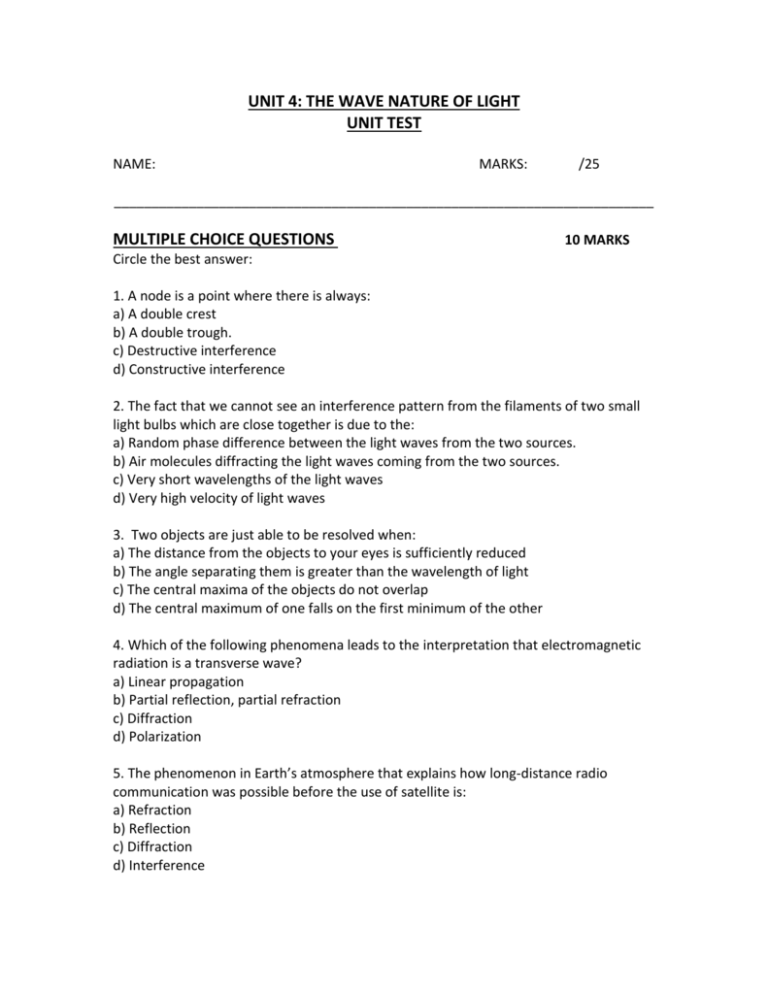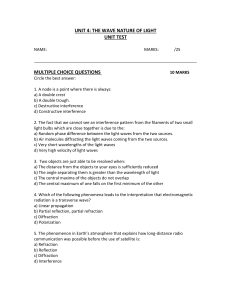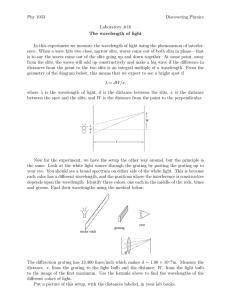the wave nature of light unit test
advertisement

UNIT 4: THE WAVE NATURE OF LIGHT
UNIT TEST
NAME:
MARKS:
/25
________________________________________________________________________
MULTIPLE CHOICE QUESTIONS
10 MARKS
Circle the best answer:
1. A node is a point where there is always:
a) A double crest
b) A double trough.
c) Destructive interference
d) Constructive interference
2. The fact that we cannot see an interference pattern from the filaments of two small
light bulbs which are close together is due to the:
a) Random phase difference between the light waves from the two sources.
b) Air molecules diffracting the light waves coming from the two sources.
c) Very short wavelengths of the light waves
d) Very high velocity of light waves
3. Two objects are just able to be resolved when:
a) The distance from the objects to your eyes is sufficiently reduced
b) The angle separating them is greater than the wavelength of light
c) The central maxima of the objects do not overlap
d) The central maximum of one falls on the first minimum of the other
4. Which of the following phenomena leads to the interpretation that electromagnetic
radiation is a transverse wave?
a) Linear propagation
b) Partial reflection, partial refraction
c) Diffraction
d) Polarization
5. The phenomenon in Earth’s atmosphere that explains how long-distance radio
communication was possible before the use of satellite is:
a) Refraction
b) Reflection
c) Diffraction
d) Interference
6. Two speakers producing exactly the same frequency and always in phase are located
on an east west line emitting sound toward the north. The speakers are 30 cm apart and
a microphone is located 40 cm due north of one speaker. Which of the following
wavelengths would produce sound with the loudest intensity at the location of the
microphone.
a) 50 cm
b) 40 cm
c) 30 cm
d) 20 cm
e) 10 cm
7. Water waves shown below are travelling from region1 into region 2
a)
b)
c)
d)
e)
In region 1, the wavelength is 5 cm and speed is 𝑉1, while in region 2 the
wavelength is 6 cm and speed is𝑉2. The ratio is 𝑉1: 𝑉2
Is 5:6
Is 6:5
Is 5:11
Cannot be determined since the frequencies are not given.
Cannot be determined since the angles of incidence and refraction are not given.
8. An interference pattern from monochromatic laser light is observed on a screen. If
λ is the wavelength of the source, w is the width of each slit, L is the distance
between the slits and the screen, and Δ x is the distance between adjacent nodal
lines in the pattern, then the distance between the centre of the tow slits d is
a) λL / Δx
b) wL / Δx
c) Δ xL / λ
d) λwL
e) None of the above.
9.
a)
b)
c)
d)
Calculate the speed of light in water (n=1.33)
2.26 x 108 m/s
3.99 x 108 m/s
3.0 x 108 m/s
3.0 x 107 m/s
10. What is the distance between adjacent slits of a diffraction grating if the third
order bright fringe for light with a 450 nm wavelength has an angle of 11.5° from
the centreline?
a) 9.0 x 10−5 m
b) 1.4 x 10−6 m
c) 6.8 x 10−6 m
d) 2.7 x 10−7 m
e) 3.0 x 10−8 m
PROBLEMS
1. The first order maximum produced by a grating is located at an angle θ= 18.0°.
What is the angle for third order maximum with the same light and same slit
width.
5 MARKS
2. Two speakers at a concert are placed 4.0 m apart and are operating in phase
producing sound at a frequency of 512 Hz. A person walking along a line located
20.0 m from the midpoint of the speakers notices a variation in the loudness of
sound. If the speed of sounds is 345 m/s, what are two possible positions where the
person would hear a quiet sound? {Wave nature of light practice test}
5 MARKS
EXTENDED RESPONSE
5 MARKS
1. Many butterflies have colored wings due to pigmentation. In some, however,
such as the morpho butterfly, the colors do not result from pigmentation and,
when the wing is viewed from different angles, the colors change. Explain
ANSWERS
1. A node is a point where there is always: (9)
a) A double crest
b) A double trough.
c) Destructive interference
d) Constructive interference
2. The fact that we cannot see an interference pattern from the filaments of two small
light bulbs which are close together is due to the: (9)
a) Random phase difference between the light waves from the two sources.
b) Air molecules diffracting the light waves coming from the two sources.
c) Very short wavelengths of the light waves
d) Very high velocity of light waves
3. Two objects are just able to be resolved when: (9)
a) The distance from the objects to your eyes is sufficiently reduced
b) The angle separating them is greater than the wavelength of light
c) The central maxima of the objects do not overlap
d) The central maximum of one falls on the first minimum of the other
4. Which of the following phenomena leads to the interpretation that electromagnetic
radiation is a transverse wave? (10)
a) Linear propagation
b) Partial reflection, partial refraction
c) Diffraction
d) Polarization
5. The phenomenon in Earth’s atmosphere that explains how long-distance radio
communication was possible before the use of satellite is: (10)
a) Refraction
b) Reflection
c) Diffraction
d) Interference
6. Two speakers producing exactly the same frequency and always in phase are located
on an east west line emitting sound toward the north. The speakers are 30 cm apart and
a microphone is located 40 cm due north of one speaker. Which of the following
wavelengths would produce sound with the loudest intensity at the location of the
microphone.
f) 50 cm
g) 40 cm
h) 30 cm
i) 20 cm
j) 10 cm
7. Water waves shown below are travelling from region1 into region 2
In region 1, the wavelength is 5 cm and speed is 𝑉1, while in region 2 the
wavelength is 6 cm and speed is𝑉2. The ratio is 𝑉1: 𝑉2
f) Is 5:6
g) Is 6:5
h) Is 5:11
i) Cannot be determined since the frequencies are not given.
j) Cannot be determined since the angles of incidence and refraction are not given.
8. An interference pattern from monochromatic laser light is observed on a screen. If λ is the
wavelength of the source, w is the width of each slit, L is the distance between the slits
and the screen, and Δ x is the distance between adjacent nodal lines in the pattern, then
the distance between the centre of the tow slits d is
f)
g)
h)
i)
j)
λL / Δx
wL / Δx
Δ xL / λ
λwL
None of the above.
9.
e)
f)
g)
Calculate the speed of light in water (n=1.33)
2.26 x 𝟏𝟎𝟖 m/s
3.99 x 108 m/s
3.0 x 108 m/s
h) 3.0 x 107 m/s
10. What is the distance between adjacent slits of a diffraction grating if the third
order bright fringe for light with a 450 nm wavelength has an angle of 11.5° from
the centreline?
f) 9.0 x 10−5 m
g) 1.4 x 10−6 m
h) 6.8 x 𝟏𝟎−𝟔 m
i) 2.7 x 10−7 m
j) 3.0 x 10−8 m
Problems
1. The first order maximum produced by a grating is located at an angle θ= 18.0°. What is
the angle for third order maximum with the same light and same slit width.
2. Two speakers at a concert are placed 4.0 m apart and are operating in phase
producing sound at a frequency of 512 Hz. A person walking along a line located
20.0 m from the midpoint of the speakers notices a variation in the loudness of
sound. If the speed of sounds is 345 m/s, what are two possible positions where the
person would hear a quiet sound? {Wave nature of light practice test}











